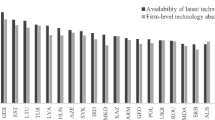Abstract
Property rights theory predicts that private firms whose ownership shares are not tradable will not be managed efficiently. This paper tests that theory by comparing the costs of rural electric cooperatives (RECs) and investor-owned electric utilities (IOUs). Separate translog cost functions are estimated for the RECs and the IOUs. The estimated costs of producing several three-product output bundles are then compared across ownership form under the assumption that all firms face identical input prices. The empirical results suggest that the cooperative sector of the electric power industry produces its output in a much less efficient manner than does the investor-owned sector.
Similar content being viewed by others
References
Alchian, A. A., and H. Demsetz. 1972. “Production, Information Costs, and Economic Organization.”American Economic Review 62 (December): 777–795.
Barten, A. P. 1969. “Maximum Likelihood Estimation of a Complete System of Demand Equations.”European Economic Review (Fall): 7–73.
Baumol, W. J., J. C. Panzar, and R. D. Willig. 1982.Contestable Markets and the Theory of Industry Structure. New York: Harcourt, Brace and Jovanovich.
Berry, D. M. 1992.Rural Electric Cooperatives and the Cost Structure of the Electric Power Industry: A Multiproduct Analysis. Unpublished Ph.D. dissertation, Auburn University.
Brigham, E. F., and J. F. Weston. 1990.Essentials of Managerial Finance, 9th Edition. Chicago: The Dryden Press.
Brown, R.S., D.W. Caves and L.R. Christensen. 1979. “Modelling the Structure of Cost and Production for Multiproduct Firms.”Southern Economic Journal (July): 256–73.
Christensen, L. R., D. Jorgenson, and L. J. Lau. 1971. “Conjugate Duality and the Transcendental Logarithmic Production Function.”Econometrica (July): 255–56.
Claggett, E. T. 1994. “A Cost Function Study of the Distributors of TVA Power.”Managerial and Decision Economics (forthcoming).
De Alessi, L. 1980. “The Economics of Property Rights: A Review of the Evidence.”Research in Law and Economics (Volume 2): 1–47.
Diewert, W. E. 1971. “An Application of the Shephard Duality Theorem: A Generalized Leontief Production Function.”Journal of Political Economy, 79: 481–507.
Greene, W. H. 1990.Econometric Analysis. New York: Macmillan Publishing.
Hausman, W. J., and J. L. Neufeld. 1991. “Property Rights Versus Public Spirit: Ownership and Efficiency of U. S. Electric Utilities Prior to Rate-of-Return Regulation.”Review of Economics and Statistics (May): 414–23.
Hayashi, P. M., M. Sevier, and J. M. Trapani. 1985. “Pricing Efficiency Under Rate of Return Regulation: Some Empirical Evidence for the Electric Utility Industry.”Southern Economic Journal (January): 776–92.
Hollas, D. R., and S. R. Stansell. 1988. “An Examination of the Effect of Ownership Form on Price Efficiency: Proprietary, Cooperative and Municipal Electric Utilities.”Southern Economic Journal (October): 336–350.
Joskow, P., and R. Schmalensee. 1983.Markets for Power. Cambridge, MA: The MIT Press.
Karlson, S. H. 1986. “Multiple-Output Production and Pricing in Electric Utilities.”Southern Economic Journal (July): 73–86.
Kaserman, D. L., and J. W. Mayo. 1991. “The Measurement of Vertical Economies and the Efficient Structure of the Electric Utility Industry.”Journal of Industrial Economics (September): 483–502.
Kmenta, J. 1986.Elements of Econometrics. New York: Macmillan Publishing.
Landon, J. H. 1983. “Theories of Vertical Integration and their Application to the Electric Utility Industry.”The Antitrust Bulletin (Spring): 101–130.
Manne, H. G. 1965. “Mergers and the Market for Corporate Control.”Journal of Political Economy (April): 110–120.
Mayo, J. W. 1984. “Multiproduct Monopoly, Regulation and Firm Costs.”Southern Economic Journal 51: 208–218.
National Rural Electric Cooperative Association (NRECA). 1990.Rural Electric Sourcebook. Washington, DC: NRECA.
Primeaux, W. J., and R. A. Nelson. 1980. “An Examination of Price Discrimination and Internal Subsidization by Electric Utilities.”Southern Economic Journal (July): 84–99.
Roberts, M. J. 1986. “Economies of Density in the Production and Delivery of Electric Power.”Land Economics (November): 378–87.
Smith, A. 1976.An Inquiry into the Nature and Causes of The Wealth of Nations, E. Cannan, Editor. Chicago: The University of Chicago Press.
U.S. Department of Agriculture, Rural Electrification Administration. 1989.1988 Statistical Report, Rural Electric Borrowers. Washington, DC: USGPO.
U.S. Department of Agriculture, Rural Electrification Administration. 1991.A Brief History of the Rural Electric and Telephone Programs. Washington, DC: USGPO.
U.S. Department of Energy, Energy Information Administration. 1990.Financial Statistics of Selected Electric Utilities, 1988. Washington, DC: USGPO.
U.S. Department of Energy, Energy Information Administration. 1991.Electric Trade in the United States, 1988. Washington, DC: USGPO.
U.S. General Accounting Office. 1980.REA Loans to Electric Distribution Systems: Policy Changes Needed. Washington, DC: USGAO (Report # CED-80-52, May).
Zellner, A. 1962. “An Efficient Method of Estimating Seemingly Unrelated Regressions and Tests for Aggregation Bias.”Journal of the American Statistical Association (June): 585–612.
Author information
Authors and Affiliations
Additional information
I would like to thank David Kaserman, Steven Caudill, T. Randolph Beard, Daniel Gropper, and David Laband for their many helpful comments on earlier drafts of this paper. This research was partially funded by the Auburn University Utilities Research Center. The views expressed here are the author's and do not necessarily reflect those of the New York State Public Service Commission.
Rights and permissions
About this article
Cite this article
Dan Berry, M. Private ownership form and productive efficiency: Electric cooperatives versus investor-owned utilities. J Regul Econ 6, 399–420 (1994). https://doi.org/10.1007/BF01418234
Issue Date:
DOI: https://doi.org/10.1007/BF01418234




